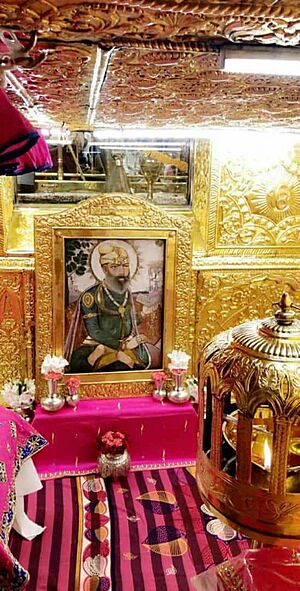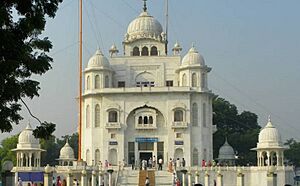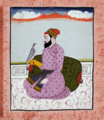Guru Tegh Bahadur facts for kids
Quick facts for kids Guru Tegh Bahadur |
|
|---|---|
| ਗੁਰੂ ਤੇਗ਼ ਬਹਾਦਰ | |
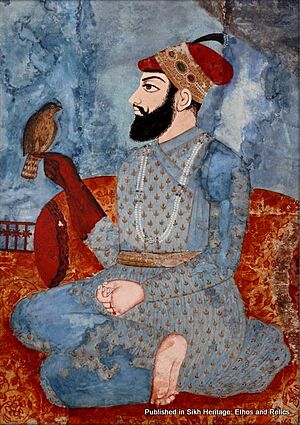
A mid-17th-century portrait of Guru Tegh Bahadur painted by Ahsan, the royal painter of Shaista Khan, governor of Bengal, circa 1668–69
|
|
| Religion | Sikhism |
| Known for |
|
| Other names | Ninth Master Ninth Nanak Srisht-di-Chadar ("Shield of The World") Dharam-di-Chadar ("Shield of Dharma") Hind-di-Chadar ("Shield of India") |
| Personal | |
| Born | Tyag Mal 1 April 1621 Amritsar, Lahore Subah, Mughal Empire (present-day Punjab, India) |
| Died | 11 November 1675 (aged 54) Delhi, Mughal Empire (present-day India) |
| Spouse | Mata Gujri |
| Children | Guru Gobind Singh |
| Parents | Guru Hargobind and Mata Nanaki |
| Religious career | |
| Period in office | 1664–1675 |
| Predecessor | Guru Har Krishan |
| Successor | Guru Gobind Singh |
| Signature | 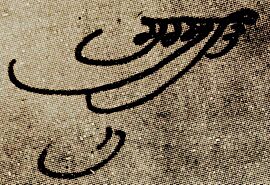 |
Guru Tegh Bahadur was the ninth of the ten Gurus of the Sikh religion. He led the Sikhs from 1665 until he was executed in 1675. He was born in Amritsar, Punjab, India, in 1621.
He was the youngest son of Guru Hargobind, the sixth Sikh Guru. Guru Tegh Bahadur was known as a brave and principled leader. He was also a wise spiritual scholar and a poet. His 115 hymns are part of the Guru Granth Sahib. This is the main holy book of Sikhism.
Guru Tegh Bahadur was executed in Delhi, India, by order of Aurangzeb. Aurangzeb was the sixth Mughal emperor. Two important Sikh holy places in Delhi mark where he was executed and where his body was cremated. These are Gurudwara Sis Ganj Sahib and Gurdwara Rakab Ganj Sahib. His day of martyrdom, called Shaheedi Divas, is remembered in India every year on November 24.
Contents
Biography of Guru Tegh Bahadur
His Early Life
Guru Tegh Bahadur was born on April 1, 1621. His birth name was Tyag Mal. He was born in Amritsar. His family belonged to the Sodhi clan of Khatris. His father, Guru Hargobind, had five sons and one daughter.
Tyag Mal was trained in Sikh culture. He learned archery and horsemanship. He also studied ancient Indian texts like the Vedas. He was married to Gujri on February 3, 1632.
Tyag Mal showed great bravery in the Battle of Kartarpur against the Mughals. Because of his courage, his father gave him the name Tegh Bahadur. This name means "Brave Sword."
In the 1640s, Guru Hargobind moved to his ancestral village of Bakala. Tegh Bahadur, his wife, and his mother also moved there. After his father's death, Tegh Bahadur continued to live a simple life in Bakala.
Becoming the Sikh Guru
In March 1664, Guru Har Krishan, the eighth Sikh Guru, became very ill with smallpox. When his followers asked who would lead them next, he said, "Baba Bakala." This meant his successor would be found in Bakala.
Many people in Bakala claimed to be the new Guru. This made it confusing for Sikhs to know who the true leader was.
There is a famous story about how Guru Tegh Bahadur was chosen. A rich trader named Makhan Shah Labana had promised 500 gold coins to the Sikh Guru. He made this promise after surviving a shipwreck. He came to Bakala to find the ninth Guru.
Makhan Shah visited each person claiming to be the Guru. He bowed and offered each one two gold coins. He believed the true Guru would know about his secret promise of 500 coins. Everyone he met accepted the two coins and said goodbye.
Then, Makhan Shah found out that Tegh Bahadur also lived in Bakala. He offered Tegh Bahadur the usual two gold coins. Tegh Bahadur blessed him and said his offering was short of the promised five hundred. Makhan Shah was amazed! He quickly gave the remaining coins. He then ran to the rooftop, shouting, "Guru ladho re, Guru ladho re!" This means "I have found the Guru, I have found the Guru!"
In August 1664, a group of Sikhs officially appointed Tegh Bahadur as the ninth Guru. This group was led by Diwan Dargha Mal. Like other Gurus after Guru Arjan's execution, Guru Tegh Bahadur had armed bodyguards. However, he lived a very simple life.
His Journeys and Teachings
Guru Tegh Bahadur traveled widely across the Indian subcontinent. He visited places like Dhaka and Assam. His goal was to share the teachings of Guru Nanak, the first Sikh Guru. Many places where he stayed became sites for Sikh temples.
During his travels, he helped communities. He started many public water wells. He also set up langars, which are free community kitchens for everyone.
He visited towns like Mathura, Agra, Allahabad, and Varanasi. His son, Guru Gobind Singh, who would become the tenth Sikh Guru, was born in Patna in 1666. At that time, Guru Tegh Bahadur was in Dhubri, Assam. There, he helped end a war between two local rulers.
After his travels, Guru Tegh Bahadur visited Rani Champa of Bilaspur. She offered him land. The Guru bought the land for 500 rupees. On this land, he founded the city of Anandpur Sahib in the Himalayas. In 1672, he traveled around the Malwa region. He wanted to meet people as the persecution of non-Muslims by the Mughal Empire was increasing.
Execution of Guru Tegh Bahadur
Why He Was Executed
Many Sikh stories explain why Guru Tegh Bahadur was executed. They say that a group of Hindu Pandits (scholars) from Kashmir asked for his help. They were facing harsh policies from Emperor Aurangzeb. Guru Tegh Bahadur decided to protect their right to practice their own religion.
According to one account, about 500 Kashmiri Pandits came to him. They were led by Pandit Kirpa Ram. They told the Guru about the religious oppression they faced. They had sought help from a Hindu deity, who told them to find the ninth Sikh Guru.
Guru Tegh Bahadur left his home to confront the Mughal officials. He was arrested at Ropar and put in jail. Four months later, in November 1675, he was moved to Delhi. There, he was told to perform a miracle or convert to Islam. The Guru refused. Three of his friends, who were arrested with him, were killed in front of him.
On November 11, 1675, Guru Tegh Bahadur was publicly executed. This happened in Chandni Chowk, a market square near the Red Fort in Delhi.
Historical Accounts
The earliest Sikh account of Guru Tegh Bahadur's execution comes from his son, Guru Gobind Singh. This account is found in the Bachittar Natak. Guru Gobind Singh wrote that his father made a great sacrifice for religious freedom. He gave up his life but did not give up his beliefs or honor. He said that true holy men do not perform tricks. Guru Gobind Singh wrote that his father's death caused the whole world to mourn.
Some non-Sikh sources from the 18th century have different views. Some say the Guru was involved in rebellious activities. They claim he gathered many followers and collected money. These sources suggest that Aurangzeb saw him as a threat to the state.
However, historians caution against taking these accounts at face value. They might have been written to justify the emperor's actions. Both Sikh and some Persian sources agree that Guru Tegh Bahadur opposed the Mughal state. This led to his execution.
Legacy and Memorials
Guru Tegh Bahadur wrote 116 hymns. These hymns are found in the Guru Granth Sahib. They cover many spiritual topics. These include human feelings, the body, the mind, sorrow, and how to find peace.
Guru Tegh Bahadur founded the city of Anandpur Sahib. He is also remembered for protecting the Kashmiri Pandits. They were being persecuted by the Mughals.
After his execution, several Sikh gurudwaras (temples) were built to honor him and his friends.
- The Gurdwara Sis Ganj Sahib in Delhi stands where he was executed.
- Gurdwara Rakab Ganj Sahib, also in Delhi, marks where one of his followers burned his own house. He did this to cremate the Guru's body safely.
- Gurdwara Sisganj Sahib in Punjab marks where Guru Tegh Bahadur's head was cremated. This was done by Bhai Jaita (later known as Bhai Jiwan Singh) to defy Mughal authority.
The execution of Guru Tegh Bahadur made Sikhs even more determined to resist unfair rule. His martyrdom helped make the protection of human rights a key part of the Sikh identity. It also inspired his son, Guru Gobind Singh, to create the Khalsa. The Khalsa is a special community of initiated Sikhs.
In India, November 24 is celebrated as Guru Tegh Bahadur's Martyrdom Day (Shaheedi Diwas). It is a public holiday in some parts of India. Guru Tegh Bahadur is honored for giving his life to protect people's freedom to practice their own religion.
Images for kids
-
Detail of a mural from Gurdwara Baba Atal Rai depicting Guru Tegh Bahadar and a young Guru Gobind Singh (then known as Gobind Das or Gobind Rai) receiving a delegation of Kashmiri Pandits whom petition their help against religious persecution of Kashmiri Hindus by the Mughal Empire. This fresco has since been lost.


